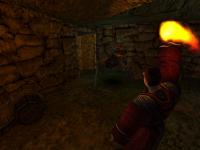| |
Site Navigation
Main
News
Forums
Games
Games Database
Top 100
Release List
Support Files
Features
Reviews
Previews
Interviews
Editorials
Diaries
Misc
Download
Gallery
Music
Screenshots
Videos
Miscellaneous
Staff Members
Privacy Statement
|
|
Project Leader and Lead Designer Tim Cain has written a TToEE dev journal at RPGVault. In it, he gives us a short history of how it came that they decided to make this game, their contacts with Infogrames and some surprises he encountered during this period. Here's an excerpt:
Infogrames wanted the new game to have a classic "feel" and to be set in the Greyhawk campaign world (as opposed to say, the Forgotten Realms or Planescape). These restrictions were fine by us, since we are somewhat traditionalists ourselves. But then they said the magic phrase "We own the rights to all of the classic modules. Pick one." I had already gone through my extensive D&D module collection, organized alphabetically by series and date of publication (did you just call me a geek?), and I had my answer ready - the Temple of Elemental Evil.
ToEE was the perfect choice. The module assumed level 1 characters at the beginning and took them up to levels 8 through 10. There was a small introductory dungeon that would be perfect for a demo, and a larger, more complex dungeon beneath the temple itself. There was a "good" village and a "bad" village, really cool monsters (including demons), and lots and lots of NPCs of various alignments and agendas. There was even an artifact (or two) waiting to be discovered, and some planar travel to be experienced. And ToEE was written by Gary Gygax himself and existed in the Greyhawk universe. Like I said, it was the perfect choice.
Of course, there were some things about the module we'd have to change. Dealing with a 1st edition module, we'd have to convert the monsters, magic items and NPCs to 3rd edition. That was expected, after all. But the module assumed the party was good, and we quickly changed that little assumption. The storyline was somewhat linear and a little vague in some areas, but that worked to our advantage. We could add plotlines for evil parties and make different endings depending on player actions while at the same time adding side quests that rounded out the sparser areas of the module.
In the end, these additions let us put our own "Troika spin" on the game and also make the game appealing to players who had experienced the original module. |
|
|





 TToEE Dev Journal at RPGVault
TToEE Dev Journal at RPGVault